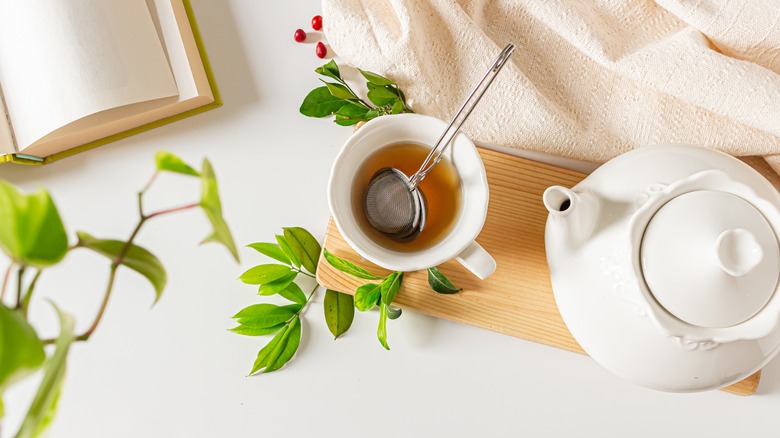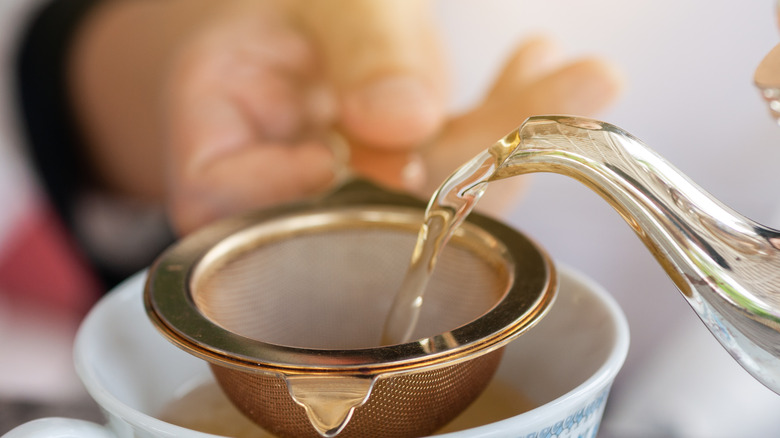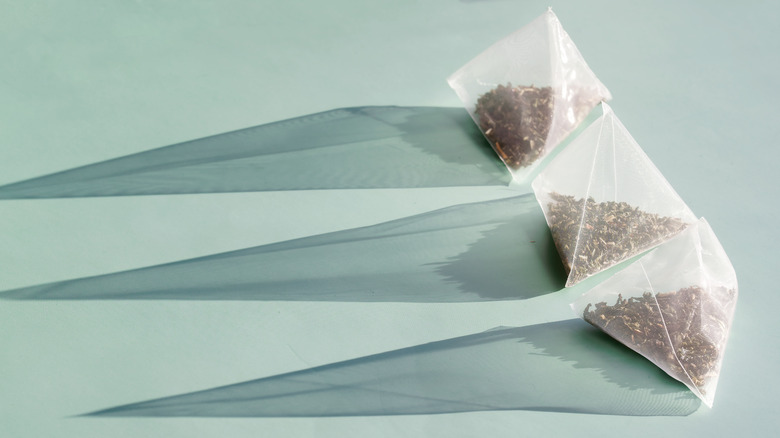The Evolution Of The Tea Strainer
Tea is a beverage with ancient roots, purportedly consumed in China since 2,700 B.C., according to Britannica. However, it appears that for much of its long history, tea was not enjoyed for pleasure, and it wasn't even made the same way it is today. Up until the third century A.D., tea was reserved for medicinal purposes, and it was made from fresh leaves. These were derived from the tea plant, Camellia sinensis (teas made from other herbs are technically called "tisanes"). By A.D. 350, however, written records began detailing the cultivation and processing of tea, and it became a daily drink for many.
If you're consuming something for strictly medicinal purposes, pleasure isn't likely to be the first thing on your mind, but once people began drinking tea on a daily basis, you can't help but wonder how many loose little tea leaves were getting swallowed up and stuck between people's teeth. Interestingly enough, this may not have been a problem in ancient China, as TeaMuse reveals that the tea leaves harvested there were larger than you're probably familiar with, and they expanded so much in the hot water that they would not slip out of the teapot into individual cups. But when the British started producing tea on plantations in India, they came up with smaller, more fragile leaves, which made some type of straining device necessary.
Tea strainers were popularized in Victorian England
There is evidence of tea strainers dating back to ancient China, the earliest models likely being made of bamboo. However, TeaMuse cites literature from the Tang dynasty describing such strainers and mentioning that their main purpose was to keep bugs out of drinking water. It was demand from British consumers that really brought tea strainers into the fold. The Victorian Era saw the debut of strainer baskets that you could place over your cup while filling it from a teapot, a method still widely used today. Another early solution to the problem was the mote spoon, a slotted spoon for fishing out loose tea leaves with a long handle used to unclog teapot spouts.
The 1800s brought tea strainers made from more luxurious materials and targeted to the upper classes. AC Silver notes that companies such as Gorham Manufacturing and even Tiffany & Co. began to make tea strainers out of sterling silver. Only the wealthy could afford such tools, so other manufacturers began making strainers from stainless steel to feed the demand from other economic brackets. But the following century would bring an earth-shattering invention so influential that it would relegate tea strainers to the status of novelty products.
The teabag changed everything
Tea strainers fell out of fashion when the world was introduced to the tea bag. According to Time Magazine, the conventional history of the tea bag says that in 1908 an American importer named Thomas Sullivan shipped out samples of his tea in silk pouches, and his customers did not realize they were supposed to remove the tea leaves from the bags before boiling them. As it turned out, brewing the tea in the bag worked fine, and Sullivan had an accidental hit on his hands. However, Time points out that seven years before Sullivan's mistake, two women in Milwaukee, Roberta C. Lawson, and Mary Molaren had filed for a patent for a tea bag they called the "tea leaf holder."
Tea strainers cannot compete with the convenience of tea bags, hence they have become far less common over the last century. However, TeaMuse notes that the typical flat teabags we use can pack the leaves too tightly together, and not leave enough room for them to expand and keep water circulating during the brewing process. Pyramid-shaped tea bags provide extra space for the leaves and water to mingle, providing one good solution to the issue, but for high-quality loose-leaf teas, you still want a good strainer on hand. Of course, it doesn't need to be made from sterling silver, but if that's your flex ... well, you do you.


